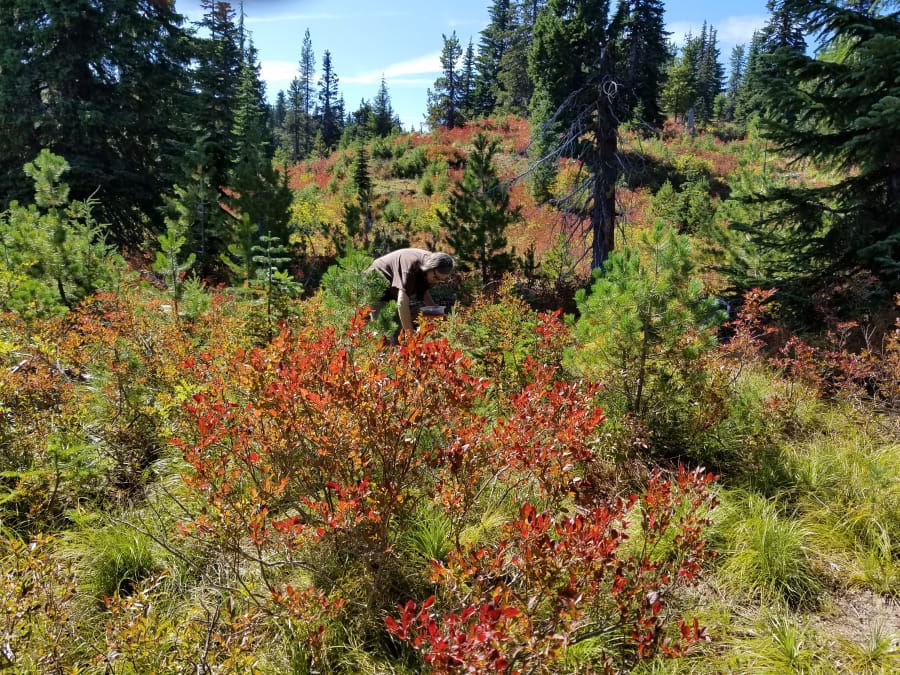When the first snap of cool weather graces the Cascade Mountains, the high-country beckons. It’s a time when the bugs of summer fade, and it’s a time when the high plateaus are drenched in a golden sunshine that ripens berries.
It’s a time when cold nights drive the trout in the high-elevation lakes to put on the feed bag for winter.
It’s a time when the huckleberry shrubs and vine maples put on their annual fall show, and the hills are festooned with splashes of bright red and scarlet.
I had planned a trip to the Sawtooth Berry Fields on the Gifford Pinchot National Forest for weeks, but my busy schedule forced me to put it off time and again. As my wife Barbara and I drove over, I wondered if we were too late for the berries.
I needn’t have worried. Even though some areas seemed to have been picked over we had no trouble finding all the berries we wanted, all while venturing no farther than 80 yards from our Jeep.
The beautiful weather had brought lots of other berry pickers out to enjoy the sunshine on this lovely Labor Day. This area is very popular and there were cars parked everywhere, but no one was having trouble finding berries.
Barry and Kelly Lint of Vancouver were enjoying the autumn sunshine as they searched for the diminutive huckleberries, even though they did say the picking was “on the outs.”
“We get out two or three times a year,” said Barry.
When asked what the two liked best about berry picking, they pointed to their bounty.
“Just the getting out, and the berries,” replied Barry. “We like to make huckleberry pancakes.”
Richard Doherty had brought his family to the area to camp and to get in a little picking. He said his parents had brought him here when he was young and he now brings his own family.
“We have been doing it for decades,” said Doherty. “We do it every year. The best part is eating them. We love to make fresh huckleberry pie.”
Doherty said they often bake the pies at their campsite with a Dutch oven.
He also added that an attendant at the Mount Adams Ranger Station had told them the berries were all gone.
Luckily for us he was wrong. It was obvious there would be berries available at least for another week or longer, if the weather holds.
One of the best parts of picking the Sawtooth Berry Fields is that the area is closed to commercial pickers, who can strip an area clean of all ripe and unripe berries. Even with the intense recreational picking that goes on here, the meadows are never stripped completely bare.
Recreational berry pickers on the national forest are required to carry a berry picking permit. The permit is free and is available online from the Gifford-Pinchot NF website, or at the ranger stations.
Recreational pickers are restricted to one gallon of berries per day, and a total of three gallons per year.
The Sawtooth Berry Fields were reserved in 1932 by a handshake agreement between Yakama Indian Chief William Yallup and Gifford Pinchot National Forest Supervisor J.R. Bruckart.
Berry harvesters are asked to pay attention to signs indicating areas reserved for use by tribal members. Basically, east of the NF-24 Road is reserved for tribal members, and everything west of the road is open to the general public.
We found plenty of smaller berries and good numbers of larger ones, and we soon found that if you simply stepped carefully off the most well-travelled areas, the bushes were still loaded with purple loot.
The Gifford Pinchot website reports that there are 12 species of huckleberry in Oregon and Washington. At times it seemed as if we were finding all of them. Some plants were still green and carried blue berries, while some were already adorned in the scarlet colors of autumn, and they produced purple berries.
While the object is to gather berries to take home, who doesn’t pop a few into his mouth from time to time? Their flavor is exquisite.
Picking the small, single berries is slow but enjoyable work, especially when the weather is fine. Eventually, our fingers dyed a deep shade of purple, we tired of the task.
We called it a day after a couple hours of work produced about half a gallon of fresh berries. We then sought the comfort of a high mountain lake to relax. The Surprise Lakes are located right in the heart of the berry fields and the clear, blue waters beckoned us.
While Barbara soaked up the sunshine on the bank of a small lake, I tossed a Kastmaster spoon from the shore. Aggressive brook trout hammered the little lure with gusto, and I managed to bank a couple and set loose a few more in just a half-hour of fishing.
Expect the berry picking to continue to slow as September progresses, but the fishing will only improve over the next month.
To get there — Take the Wind River Highway north from Carson to Meadow Creek Road, (NF-30), and then follow NF-30 north to NF-24, which will take you north to the berry fields.
Take a good map and compass if you do not have a high-quality GPS. You can ‘t count on cell phone coverage here.
For more information: Call the Mount Adams Ranger District, GPNF, 509-395-3400.




